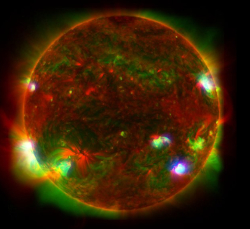Some of the hottest spots in the Sun’s atmosphere appear in the telescope’s X-ray view.
Even on a sunny day, human eyes can’t see all the light our nearest star gives off. A new image displays some of this hidden light, including the high-energy X-rays emitted by the hottest material in the Sun’s atmosphere, as observed by NASA’s Nuclear Spectroscopic Telescope Array (
NuSTAR). While the observatory typically studies objects outside our solar system – like massive black holes and collapsed stars – it has also provided astronomers with insights about our Sun.
In the composite image ...
NuSTAR data is represented as
blue and is overlaid with observations by the X-ray Telescope (
XRT) on the Japanese Aerospace Exploration Agency’s
Hinode mission, represented as
green, and the Atmospheric Imaging Assembly (
AIA) on NASA’s Solar Dynamics Observatory (
SDO), represented as
red. NuSTAR’s relatively small field of view means it can’t see the entire Sun from its position in Earth orbit, so the observatory’s view of the Sun is actually a mosaic of 25 images, taken in June 2022.
The high-energy X-rays observed by NuSTAR appear at only a few locations in the Sun’s atmosphere. By contrast, Hinode’s XRT detects low-energy X-rays, and SDO’s AIA detects ultraviolet light – wavelengths that are emitted across the entire face of the Sun.
NuSTAR’s view could help scientists solve one of the
biggest mysteries about our nearest star: why the Sun’s outer atmosphere, called the corona, reaches more than a million degrees – at least 100 times hotter than its surface. This has puzzled scientists because the Sun’s heat originates in its core and travels outward. It’s as if the air around a fire were 100 times hotter than the flames. ...
 The Energetic Sun
The Energetic Sun
